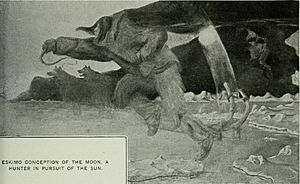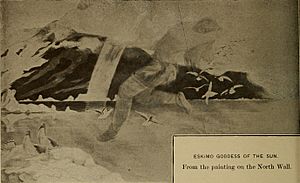Sun and moon (Inuit myth) facts for kids

The Sun and the Moon is an unipkaaqtuat, a special story from Inuit folklore. These stories help explain how the world works. This particular tale explains why the Sun and Moon move across the sky. It says they are a brother and sister who are always chasing each other. The story also tells us why the Moon looks spotted or gray. It says this is from soot smeared on his face.
Contents
Meet the Sun and Moon
In this story, the brother is often called Aningaat. Sometimes he is simply known as the Moon. In the Inuktitut language, Moon is called Taqqiq or ᑕᖅᑭᖅ.
The sister is usually called Siqiniq, which means Sun in Inuktitut (Siqiniq, ᓯᕿᓂᖅ). In Greenlandic, she is called Seqineq. People also sometimes just call her "Aningaat's sister."
Different Story Versions
This old Inuit story has two main parts. Sometimes they are told together, and sometimes separately.
The first part is about a blind boy and a loon. The second part tells how the brother and sister become the Sun and Moon.
The Blind Boy and the Loon
This part of the story begins with Aningaat and his sister. They are orphans living with their grandmother. In some versions, it's their mother or stepmother. Aningaat is blind.
One day, a polar bear comes near their home. The blind brother shoots the bear through a window. But his grandmother lies. She says he only hit the window frame. The grandmother secretly cuts up the bear. She keeps the meat for herself and the girl. The boy is given only dog meat. He is not even allowed to live in the main house. But his sister secretly gives him bear meat.
Aningaat asks his sister to take him to a lake. Many red-throated loons live there. The brother stands by the lake. He hears a sound like a kayak and a voice invites him to sit. He gets in and is paddled to the middle of the lake. In some versions, he is just led into the water.
They go underwater. When Aningaat needs air, they come up. After breathing, they dive again. The stranger asks if he can see. This happens many times. Each time, the boy can see a little more. By the end, he is no longer blind. The stranger who helped him was a loon.
When Aningaat returns home, he sees the bearskin. He asks his grandmother about it. She lies again, saying she got it from visitors.
Now that he can see, Aningaat makes a harpoon. He uses it to hunt white whales by the shore. One day, his grandmother hunts with him. She holds the harpoon line. She tells him to harpoon the smallest whale. But he harpoons the largest one. The big whale pulls her into the water. She comes up once, then disappears. In some stories, she turns into a narwhal, with her hair becoming its horn.
Aningaat and his sister move to a new camp. There, the sister is attacked while getting water. Her brother saves her. He helps her heal, and they move to another new camp.
How They Became the Sun and Moon
This part of the story often starts with a big celebration. Someone enters the sister's home in the dark. They put out her lamp, called a qulliq. Then, someone bothers her.
The sister knows this might happen again. So, she puts soot on her face. Her visitor comes again, and this time, he gets soot on himself. When he leaves, she follows him. She hears laughter from the community hall, called a qaggiq. She goes inside and sees. Everyone is laughing at Aningaat because he has soot on his face. She is very upset by this.
A chase begins. Both the brother and sister are carrying torches. But the brother's torch goes out. The chase goes up into the sky. There, they become the Sun and the Moon. They are still chasing each other across the sky today.
See also
- First sunrise, a special Inuit ritual
- Brother and sister who became the sun and moon, a Korean story
References


